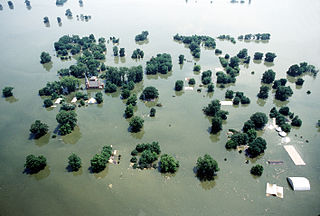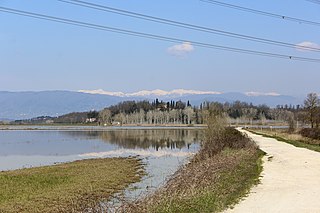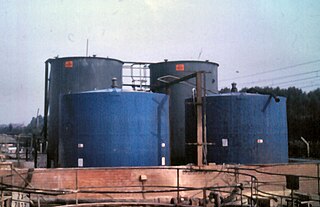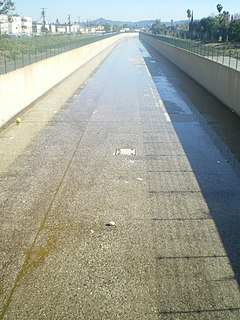 W
WFlood control methods are used to reduce or prevent the detrimental effects of flood waters. Flood relief methods are used to reduce the effects of flood waters or high water levels.
 W
WA 100-year flood is a flood event that has a 1 in 100 chance of being equaled or exceeded in any given year.
 W
WLago di Bientina, also known as Lago di Sesto, was a lake in Tuscany, Italy. Located to the north of the town of Bientina, between Lucca and Pisa, the lake was historically subject to numerous efforts at drainage due to its tendency to flood. Early attempts at canal-building and drainage in the 16th century were hampered by the lake's connection with the Arno River, which often led to backflow and even increased flooding.
 W
WBunding, also called a bund wall, is a constructed retaining wall around storage "where potentially polluting substances are handled, processed or stored, for the purposes of containing any unintended escape of material from that area until such time as a remedial action can be taken."
 W
WIn Japanese architecture, an engawa or en (縁) is an edging strip of non-tatami-matted flooring, usually wood or bamboo. The ens may run around the rooms, on the outside of the building, in which case they resemble a porch or sunroom.
 W
WA flash flood warning is an alert issued by national weather forecasting agencies to warn the public that a flash flood is imminent or occurring in the warned area. A flash flood is a sudden, violent flood after a heavy rain, or occasionally after a dam break. Rainfall intensity and duration, topography, soil conditions, and ground cover contribute to flash flooding.
 W
WA flood bypass is a region of land or a large man-made structure that is designed to convey excess flood waters from a river or stream in order to reduce the risk of flooding on the natural river or stream near a key point of interest, such as a city. Flood bypasses, sometimes called floodways, often have man-made diversion works, such as diversion weirs and spillways, at their head or point of origin. The main body of a flood bypass is often a natural flood plain. Many flood bypasses are designed to carry enough water such that combined flows down the original river or stream and flood bypass will not exceed the expected maximum flood flow of the river or stream.
 W
WFlood control channels are large and empty basins which let water flow in and out or dry channels that run below the street levels of some larger cities, so that if and when a flood occurs, the water will run into these channels, and eventually drain into a river or other body of water. Flood channels are sometimes built on the former courses of waterways as a way to reduce flooding.
 W
WA floodplain or flood plain or flood-plain is an area of land adjacent to a stream or river which stretches from the banks of its channel to the base of the enclosing valley walls, and which experiences flooding during periods of high discharge. The soils usually consist of clays, silts, sands, and gravels deposited during floods.
 W
WA floodway is a flood plain crossing for a road, built at or close to the natural ground level.
 W
WA HydroSack or a HydroSnake is a brand name for a flood control sandbag alternative made by Gravitas International of Cheshire, North West England. They are very lightweight and thin until they come into contact with water, then they begin to retain water until they have reached capacity. The devices then resist any further water excess. These can be used to absorb, resist and redirect flowing water.
 W
WA levee, dike, dyke, embankment, floodbank or stopbank is an elongated naturally occurring ridge or artificially constructed fill or wall that regulates water levels. It is usually earthen and often parallel to the course of a river in its floodplain or along low-lying coastlines.
 W
WA sandbag or dirtbag is a bag or sack made of hessian (burlap), polypropylene or other sturdy materials that is filled with sand or soil and used for such purposes as flood control, military fortification in trenches and bunkers, shielding glass windows in war zones, ballast, counterweight, and in other applications requiring mobile fortification, such as adding improvised additional protection to armoured vehicles or tanks.
 W
WA storm drain, storm sewer, surface water drain/sewer, or stormwater drain is infrastructure designed to drain excess rain and ground water from impervious surfaces such as paved streets, car parks, parking lots, footpaths, sidewalks, and roofs. Storm drains vary in design from small residential dry wells to large municipal systems.
 W
WWashland or washes are areas of land adjacent to rivers which are deliberately flooded at times when the rivers are high, to avoid flooding in residential or important agricultural areas. They often provide for overwintering wildfowl, and several include important nature reserves.